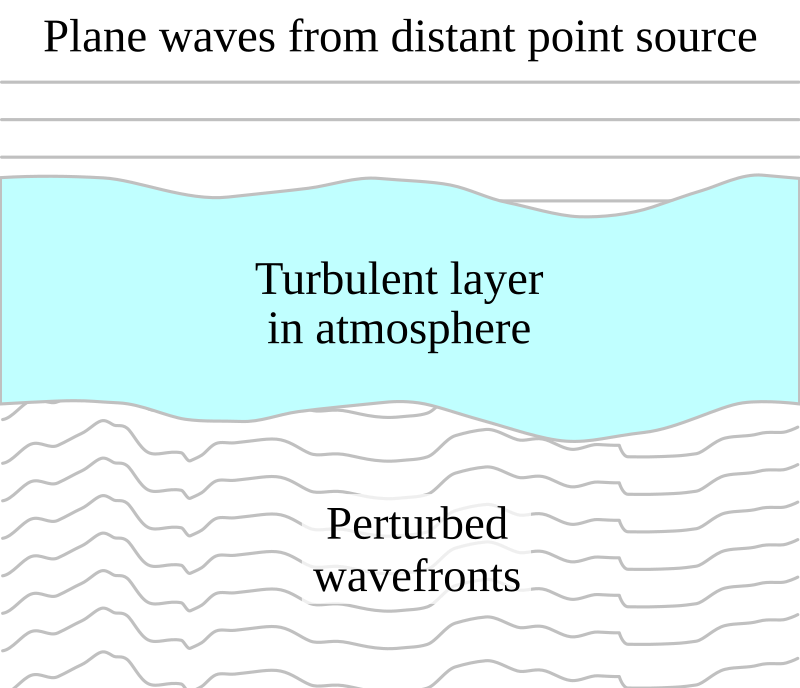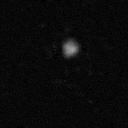what causes the image of a star to "twinkle" or scintillate?
When we wait at the heaven, we see different types of objects. Some are human-fabricated (like the International Space Station), some are from our solar organisation (like Venus or Saturn), only many are twinkling, shiny objects — of course, stars from outside our solar organisation.
Stars take fascinated humans since fourth dimension immemorial, especially because sometimes, they seem to twinkle. Stars don't really twinkle per se — the twinkling we observe here has more to practise with the atmosphere on Earth rather than the stars themselves. There are three main factors that influence how stars "twinkle", and to truly understand them, nosotros need to take a brusque dive into some atmospheric physics.

Turbulence
The beginning physical phenomenon that makes stars appear to twinkle is turbulence.
Nosotros observe stars that are far abroad because the light that they emit reaches our eyes (or telescopes). But in order to do that, information technology must start pass through the atmosphere. That means that light is indirectly subjected to phenomena that affect the Earth's atmosphere.
Turbulence is a phenomenon that frequently happens on smaller scales. In the atmosphere, nosotros have big-calibration phenomena like cold fronts or hurricanes happening every day, but within these events, turbulence is significant on a pocket-sized scale. So common cold fronts bring large thunderstorms, the clouds within the front can make the heaven turbulent, and that's when the pilot tells you "Ladies and gentlemen, we're experiencing some turbulence."

There are several types of turbulence, including ane called thermal turbulence — which happens when there is a mix between hotter and colder air. This could happen whether the heaven is cloudy or not. When a mass of air in the atmosphere is hotter than its surroundings, it starts to rise, creating convective currents. Basically, you end up with moving columns or pockets of heated air that arise from warmer surfaces of the earth.
These moving pockets of air can create turbulence, and in the process, they also distort light that passes through them.
When it comes to stars, twinkling is caused by the passing of light through different layers of the turbulent atmosphere. This is more pronounced almost the horizon than straight overhead since calorie-free rays well-nigh the horizon pass through denser layers of the temper, but twinkling (technically called scintillation) can be observed on all parts of the heaven.
But there's more to this story.
Scintillation

When light passes through any medium (including the Globe'south atmosphere), some of it is reflected dorsum, while some passes through the atmosphere, but at a different angle — something chosen refraction. When the atmosphere is turbulent in a region, the refraction angle is non constant, and then light can alter path speedily.
Altering the refractive alphabetize changes the apparent position of objects, but like the harbinger in a glass of h2o experiment, it looks bent. Then the turbulent heaven, constantly changing the refractive index makes stars appear to be moving, so they twinkle, or scintillate.

Due to scale differences, if an astronomical object is big enough compared to the turbulence, information technology won't affect the style we see it. But the light of a smaller object (or 1 that's further away) will be affected equally it crosses the turbulent air. That's the reason why planets twinkle less (or almost don't twinkle at all) — they are closer and it makes them 'bigger' compared to the turbulence.
Fortunately, atmospheric scientists developed a way to monitor changes in the refractive alphabetize of the temper due to turbulence. They use instruments to mensurate the turbulence and use it to try to estimate a future result.
Unlike skies
For astronomers, twinkling can exist quite problematic. And then they look for the "best heaven" to avoid the phenomenon. Usually, this means an environment whose climate is very dry out. When that'southward not possible, they try to find the dryness by placing the instruments at a high altitude. Whenever is possible to combine altitude and mostly dry weather, they have a good spot for a telescope.
In the images above nosotros run into the difference very clearly: both skies were articulate when the images were taken, but 1 (on the left) was less turbulent than the other (on the right). On the left, we come across a video of a star recorded on Mount Fuji in Nihon — the star appears to be bouncing chaotically due to a turbulent sky. On the right, we come across a recording of the same star taken on the Andes Mountains in Chile, a very dry, loftier-altitude area; the star bounces, only much less than in the Japanese images.

And so stars don't exactly twinkle, merely they do appear to twinkle from here on Earth. For astronomers, though, making certain they eliminate the "twinkling" is important.
Of course, if you set your telescopes in infinite, you lot don't have these problems considering your ascertainment point is above the atmosphere. Simply even here on Earth, astronomers are conscientious to pick the best locations for placing large optical telescopes. They typically look for the driest areas, at the highest altitude possible, without any low-cal pollution. There's another consideration: because the air is usually flowing from west to eastward because of Globe's rotation, a way to avoid pollution is placing telescopes on w coasts or in ilands in the middle of the ocean. This rules out the vast majority of places on World, which is why astronomers are and then detail nigh where they identify their telescopes.
hackworthwitalarry1947.blogspot.com
Source: https://www.zmescience.com/other/feature-post/why-stars-twinkle-10112021/


0 Response to "what causes the image of a star to "twinkle" or scintillate?"
Post a Comment